Part One: Melody
Focuses on single note soloing. Learn how to effortlessly solo through complex chord changes.
Free Jazz Guitar Lessons with Chris Standring
The diminished 7th chord is one of those oddities in
music where it seems to be a law unto itself. It is a wonderful 'flavor'
chord which can decorate music and create a nice harmonic surprise.
However, as with all new chords, we should first look at the make up
of the chord and then play through some music examples so you can familiarize
yourself with how it is commonly used.
Remember our C major chord scale sequence?

Chord vii spells out a B diminished triad. Just to remind you, a diminished triad is essentially two minor third intervals played together. In other words, to look at a B diminished triad, play the note B on the fourth string at the 9th fret on your fretboard, then play a note 3 frets up (minor 3rd interval) on the same string. Then play another note 3 frets further up on the same string. Play those notes together (obviously on different strings) and you have a diminished triad. Something like this:

Now, a diminished 7th chord is where you add one more minor third interval to the chord. So in a perfect world it might be played like this:

But we don't always live in a perfect world and as you can see this chord fingering is simply much too difficult to use in any practical situation. We shouldn't have to be gymnasts to get around the fretboard! We need to re-finger it so it is easy to play. Now the interesting thing about a diminished 7th chord is that, after you add that last minor 3rd interval, should you try to add even one more minor 3rd interval, you will arrive back at our root note of 'B'. Try it and see. Maybe play the note B on the 3rd string (so you don't run out of frets!) Like this:

So
if we arrive back at our root note of 'B' then we must extrapolate from
this that from whatever notes you start from, if you keep adding minor
3rd intervals upwards, you will arrive back at your same starting note
after those 4 notes. Correct? So this means that the same four note
diminished 7th chord shape can therefore serve as four different
diminished 7th chord names.
OK let's try to understand that a little better. If we now know that
the four note diminished 7th chord is made up of four minor 3rd intervals,
then the make up of the chord could be broken down as follows:
Root
b3
b5
6th (or diminished 7th which is a double flattened 7th - yikes!!! I
hear you cry - OK this is starting to get deep, please don't worry,
just learn the interval names for now)
Here is a really good voicing for a diminished 7th chord that will serve
for four different diminished 7th chord names:
B dim7 | D dim7 | F dim7 |
G# or Ab dim7

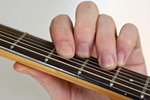
Because diminished 7th chords have four notes that serve for other diminished 7th chord names, we need to start getting used to seeing root notes that don't necessarily sit on the bottom two strings of the guitar. Study the chord voicing above and play it on the guitar, looking at the interval names written in red. Now shift that exact same shape up 3 frets so all the notes of the chord are shifted up a minor 3rd interval. Now look at the interval names in red. It is the same chord shape but the interval names now reside on different strings.
B dim7 | D dim7 | F dim7 |
G# or Ab dim7

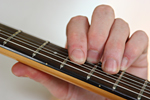
Shift the same pattern up again another minor third
interval and again look at the interval names:
B dim7 | D dim7 | F dim7 |
G# or Ab dim7

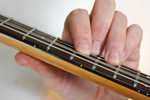
And finally, shift up one more minor 3rd interval:
B dim7 | D dim7 | F dim7 | G# or Ab dim7

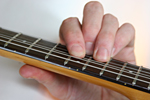
Within one diminished 7th chord, you can use the same shape for four other diminished 7th chord names. To get you started I strongly suggest that you learn to play a shape where the root is on either the top string or the bottom string. So if we still concentrate on our B diminished 7th chord, the first voicing you should learn is this one where the root is on the top string:
B dim7

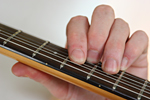
Here is another nice diminished 7th voicing where you can visualize a root on the bottom string. Notice that you will need to barre with your 1st finger over 3 strings and mute the 5th string (do this with your 2nd finger on left hand) and top string.
B dim7 (6th string root)

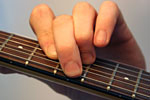
And here is a movable diminished voicing with a root on the 5th string:
B dim7 (5th string root)

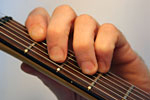
Diminished 7th chords can be used in a variety of ways.
They can be used to serve as 'connecting' chords where a diminished
7th chord can be used as a 'passing' chord to get from one chord to
another. You'll see what I mean in the upcoming examples. They can
also be used to create harmonic surprise, so where you might expect
a more familiar chord, because the chord is made up of some juicy
scrunch notes, using this chord can create some musical interest.
Free online jazz guitar lessons for beginners, intermediates and advanced.
Online jazz guitar instruction from recording artist Chris Standring
Join The Inside Track membership and get access to all Chris Standring's guitar instructional programs, all in one place.
It has been many years since the first edition of Play What You Hear (originally released in 2000). Now volume two is here with new ideas and concepts, complete with audio, video, traditional notation and TAB throughout. High resolution pdf available for printing the entire program. For intermediate and advanced players.
Focuses on single note soloing. Learn how to effortlessly solo through complex chord changes.
Focuses on chord melody. Learn new harmonic devices and understand chords in a whole new way.
Study Chris Standring's six recorded solos, transcribed with audio and high def video.
Copyright © PlayJazzGuitar.com - All Rights Reserved.